The December 2019 regulation revision expands the scope from televisions to electronic displays in general, including also computer displays (monitors) and signage displays. Excluded are e.g. small displays (<100 cm²), digital photo frames, projectors, medical displays and status displays.
Source: estimations from the Ecodesign Impact Accounting Overview Report 2023
Scope
The following table shows some examples of products in scope and out of scope
| In Scope | Out of Scope |
|---|---|
|
|
Check the complete list in the Regulation.
Ecodesign Requirements
Rules on ecodesign electronic displays are mandatory for all manufacturers and importers wishing to sell their products in the EU.
From 1 March 2021, the Regulation on ecodesign for electronic displays (EU) 2019/2021 repeals and replaces Regulation on ecodesign for televisions (EC) 642/2009.
The regulation sets new minimum requirements adapted to modern technologies and includes elements to improve reparability. The parts of a television that can easily break down have to be available to consumers and repairers within three weeks, for at least seven years after the date as of which a model is no longer in production. This also applies to repair instructions and software updates.
The new regulation further tightens the maximum allowed power consumption when the television is in off or in standby. In addition, smart televisions must have the so called network standby disabled in their default configuration to better save energy when the television is not in use.
Energy Label
Electronic displays, like televisions, computer monitors or signage displays, are labelled on an energy efficiency scale that ranges from A (most efficient) to G (least efficient). The new scaling system is improved and better takes into account the screen area. The new labels will also show the efficiency of a product when it shows content in HDR, as it can consume twice as much energy as other settings. In addition, the label will also show information on the diagonal size of the display and its resolution, so that consumers can better compare similar displays.
The European Product Registry for Energy Labelling (EPREL) offers more detailed information on models placed on the EU market. This can be accessed by scanning the QR code featured on the new energy labels. The database provides additional information such as the consumption in standby mode, panel technology, whether voice recognition, automatic brightness control and a room sensor are present, or the minimum duration of guarantee offered by the supplier.
From 1 March 2021, Regulation on energy labelling for electronic displays (EU) 2019/2013 repeals and replaces Regulation (EU) 1062/2010.
Label information
All electronic displays in the scope of the regulation have a specific energy label which shows the energy consumption in SDR (Standard Dynamic Range) and HDR (High Dynamic Range),the screen resolution and diagonal.
| Understanding the Electronic Display Energy Label | |
|---|---|
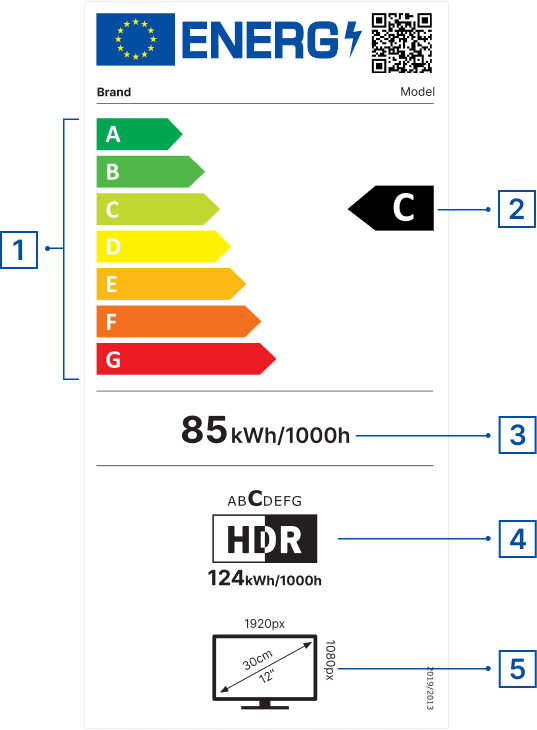 |
|
Eco-Tips and Tricks
- Be aware that the TV is one of the largest household consumers
- Turn down the brightness
- Turn on the Automatic Brightness Control (if available)
- Use as much as possible the default picture mode – it is the only one with guaranteed low power
- Be aware that certain picture modes like “gaming” or “dynamic” can easily double the power consumed
- HDR can also increase the power consumption significantly.
- If longer not in use - unplug the TV or monitor to avoid its standby consumption
- Check the power consumption in EPREL before buying a new one.
Highlights
Despite the increasing stock and size of displays and the addition of functionalities, their total electricity consumption is expected to decrease from 84 TWh/a in 2015 to 62 TWh/a in 2030.
Facts & Figures
This graphic shows the estimated sales, stock, electricity consumption (primary), greenhouse gas emissions, consumer expenses and business revenues for the years 2010 and 2030.
The anticipated effect of the measures with respect to the projected evolution of the parameters without such measured in place is indicated by the dashed patterns and their corresponding figures.
|
Product: Electronic Displays Measures: Regulation (EU) 2019/2021, Regulation (EU) 2019/2013 |
|---|
|
|
|
SALES (x1000 units) 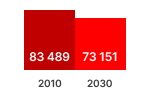 |
STOCK (x1000 units) 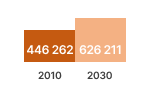 |
Electricity (TWh/a) 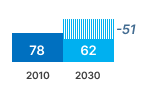 |
|
GHG-EMISSION 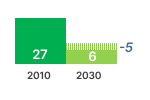 |
CONSUMER EXPENSES 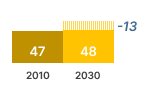 |
REVENUES 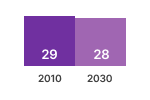 |
Source: estimations from the Ecodesign Impact Accounting Overview Report 2023
Expected Savings
Efficiency
Despite the increasing stock and size of displays and the addition of functionalities, their total electricity consumption is expected to decrease from 84 TWh/a in 2015 to 62 TWh/a in 2030.
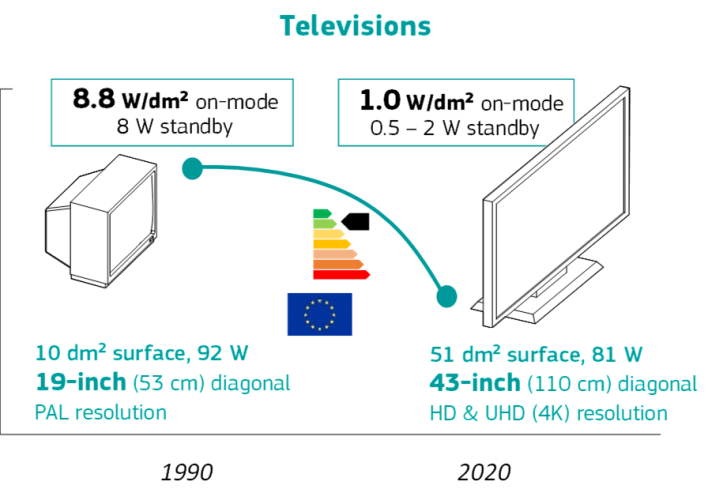
Over the past decades, the power consumption (in on-mode) per unit display area has been rapidly decreasing. In 1990, TVs and monitors consumed around 9 W per dm² display surface in average. In 2020 this dropped to around 1 W/dm². The prognosis for 2030 is that specific power consumption will further reduce to 0.4 W/dm² for both display types.
As the power consumption in on-mode drops, the power consumption in standby-mode becomes relatively more important. In 2020 10% of the overall energy consumption of displays was consumed in standby-mode, but this is expected to increase to 18% in 2030. Due to the regulations, the standby power consumption of smart TVs is expected to decrease from 6.4 W in 2015 to 4 W in 2030.
Total EU27 On-Mode Electricity Consumption for TVs VS. average Viewable Display Area
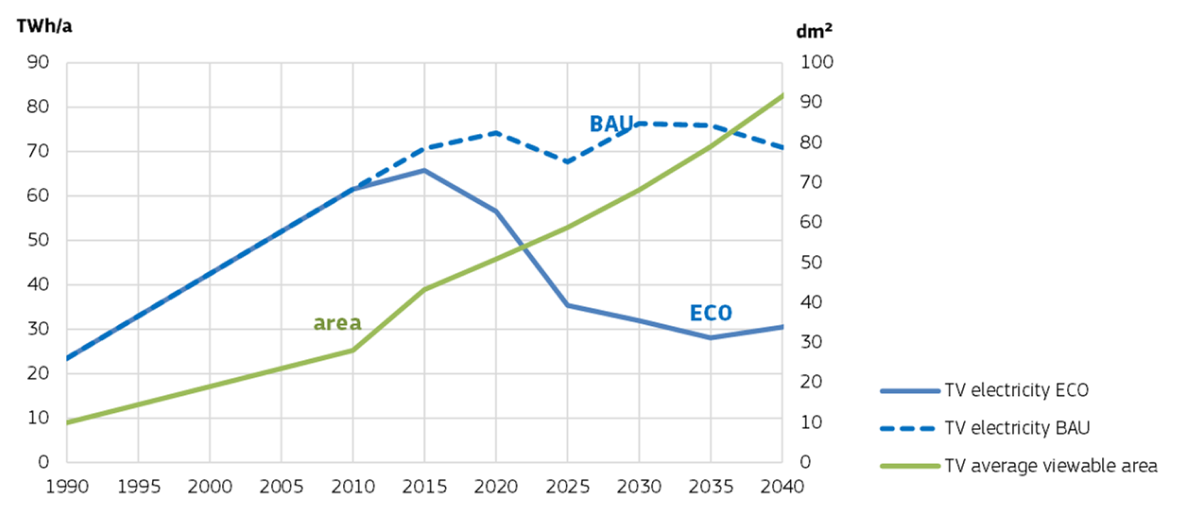
Source: estimations from the Ecodesign Impact Accounting Overview Report 2023

Suppliers
To fulfil the energy labelling obligations, suppliers must ensure that:
(a) each electronic display is supplied with a label in printed form in the format and containing the information set out in Annex III;
(b) the values of the parameters included in the product information sheet, as set out in Annex V, are entered into the public part of the product database;
(c) if specifically requested by the dealer, the product information sheet shall be made available in printed form;
(d) the content of the technical documentation, as set out in Annex VI, is entered into the product database;
(e) any visual advertisement for a specific model of electronic display, including on the internet, contains the energy efficiency class and the range of efficiency classes available on the label in accordance with Annex VII and Annex VIII;
(f) any technical promotional material concerning a specific model of electronic display, including on the internet, which describes its specific technical parameters, includes the energy efficiency class of that model and the range of efficiency classes available on the label, in accordance with Annex VII;
(g) an electronic label, in the format and containing the information as set out in Annex III, shall be made available to dealers for each electronic display model;
(h) an electronic product information sheet, as set out in Annex V, is made available to dealers for each electronic display model;
(i) in addition to point (a), the label shall be printed on the packaging or stuck on it.
The energy efficiency class shall be based on the energy efficiency index calculated in accordance with Annex II.

Dealers
To fulfil the energy labelling obligations, dealers must ensure that:
(a) each electronic display, at the point of sale, including at trade fairs, bears the label provided by suppliers in accordance with point 1(a) of Article 3 displayed on the front of the appliance or hung on it or placed in such a way as to be clearly visible and unequivocally associated to the specific model; provided that the electronic display is kept in on-mode when visible to customers for sale, the electronic label in accordance with point 1(g) of Article 3 displayed on the screen may replace the printed label;
(b) where an electronic display model is displayed in a point of sale without any unit displayed out of the box, the label printed on the box or stuck on it shall be visible;
(c) in the event of distance selling or telemarketing, the label and product information sheet are provided in accordance with Annexes VII and VIII;
(d) any visual advertisement for a specific model of electronic display, including on the internet, contains the energy efficiency class and the range of efficiency classes available on the label, in accordance with Annex VII;
(e) any technical promotional material concerning a specific model of electronic display, including technical promotional material on the internet, which describes its specific technical parameters, includes the energy efficiency class of that model and the range of efficiency classes available on the label, in accordance with Annex VII.

Policy
Ongoing legislative work
Please check the ongoing initiatives on the Have your say portal.
Regulation (EU) 2019/2021 of 1 October 2019 laying down ecodesign requirements for electronic displays pursuant to Directive 2009/125/EC of the European Parliament and of the Council, amending Commission Regulation (EC) 1275/2008 and repealing Commission Regulation (EC) 642/2009 (OJ L 315, 5.12.2019, pp. 241-266).
Regulation (EU) 2019/2013 of 11 March 2019 supplementing Regulation (EU) 2017/1369 of the European Parliament and of the Council with regard to energy labelling of electronic displays and repealing Commission Delegated Regulation (EU) No 1062/2010 (OJ L 315, 5.12.2019, pp. 1-28).
What is the aim of the regulations?
Regulation (EU) 2019/2021 establishes ecodesign requirements for the sale or putting into service of electronic displays, including televisions, monitors and digital signs. The regulation repeals Regulation (EC) 642/2009 that only applied to televisions and television monitors.
Delegated Regulation (EU) 2019/2013 lays down rules on the labelling of and supply of additional product information on these products. It repeals Delegated Regulation (EU) 1062/2010 that only applied to televisions and television monitors .
The regulations do not apply to certain display products, such as projectors, medical displays, small electronic displays or all-in-one video conference systems. Other devices, such as broadcast, professional and security displays, digital interactive whiteboards, or digital photo frames, have only to meet some of the requirements, such as those relating to material efficiency (ease of repair and recycling).
Key points
Ecodesign requirements in line with Directive 2009/125/EC:
- energy efficiency requirements
- allowances and adjustments
- off-mode and standby requirements
- material efficiency requirements
- information availability requirements
Regulation (EU) 2019/2013 sets out energy labelling requirements in line with the Framework Regulation (EU) 2017/1369:
- energy efficiency classes
- energy efficiency index
- allowances and adjustments
- the energy label;
From when do the regulations apply?
They both apply from 1 March 2021. However, the requirement that electronic displays be supplied with a printed label in the format and containing the information set out in Annex III of Delegated Regulation (EU) 2019/2013 applies from 1 November 2020.
Background
- Directive 2009/125/EC establishes a framework to set ecodesign requirements for energy-related products. The Commission must set these for products which are widely sold and traded in the EU and have a significant environmental impact.
- Regulation (EU) 2017/1369 establishes a framework to set energy labelling requirements for energy-related products to enable consumers to choose more efficient products to reduce their energy consumption.
- The WEEE Directive set requirements on recovery and recycling of waste electrical and electronic equipment (WEEE) to reduce the negative environmental effects of generating and managing WEEE, and of the use of resources.
For more information, see:
- Televisions — Energy labelling and ecodesign requirements (European Commission)
- About the energy label and ecodesign (European Commission).
Disclaimer: please pay attention to possible updates/changes as indicated in the Official Journal (green dot)
Useful Links
Regulation (EU) 2017/1369 of the European Parliament and of the Council of 4 July 2017 setting a framework for energy labelling and repealing Directive 2010/30/EU (OJ L 198, 28.7.2017, pp. 1-23)
Communication from the Commission — Ecodesign Working Plan 2016-2019 (COM(2016) 773 final, 30.11.2016)
Communication from the Commission to the European Parliament, the Council, the European Economic and Social Committee and the Committee of the Regions — Closing the loop — An EU action plan for the Circular Economy (COM(2015) 614 final, 2.12.2015)
Commission Regulation (EU) 617/2013 of 26 June 2013 implementing Directive 2009/125/EC of the European Parliament and of the Council with regard to ecodesign requirements for computers and computer servers (OJ L 175, 27.6.2013, p. 13-33)
Directive 2012/19/EU of the European Parliament and of the Council of 4 July 2012 on waste electrical and electronic equipment (WEEE) (OJ L 197, 24.7.2012, pp. 38-71)
Commission Delegated Regulation (EU) 1062/2010 of 28 September 2010 supplementing Directive 2010/30/EU of the European Parliament and of the Council with regard to energy labelling of televisions (OJ L 314, 30.11.2010, pp. 64-80)
Directive 2009/125/EC of the European Parliament and of the Council of 21 October 2009 establishing a framework for the setting of ecodesign requirements for energy-related products (OJ L 285, 31.10.2009, pp. 10-35)
Commission Regulation (EC) 1275/2008 of 17 December 2008 implementing Directive 2005/32/EC of the European Parliament and of the Council with regard to ecodesign requirements for standby and off mode electric power consumption of electrical and electronic household and office equipment (OJ L 339, 18.12.2008, pp. 45-52)
Regulation (EU) 2021/340 amending Regulations (EU) 2019/2013 to 2018
Regulation (EU) 2021/341 amending Regulations (EU) 2019/424, 1781 and 2020 to 2024
Commission communication: Transitional methods of measurement 2010/C 114/05


